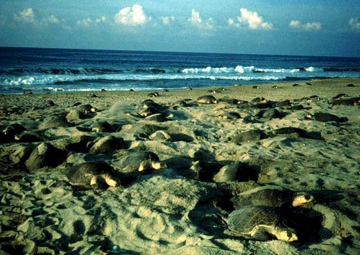Survival is all about change. Species that can adapt to changing conditions will live on, while those that can’t are doomed. That’s why a study released a couple of years ago may be good news for olive ridley sea turtles in the eastern Pacific Ocean. The study showed that the turtles go with the flow — they aren’t stuck in rigid patterns. In a world where the climate is changing in a hurry, that could help ensure the turtles’ survival.
 Texas A&M University researcher Pamela Plotkin followed 30 turtles in tropical waters from Mexico to Peru, tracking their motions with satellites. She followed individual turtles for periods ranging from about a week to more than two years.
Texas A&M University researcher Pamela Plotkin followed 30 turtles in tropical waters from Mexico to Peru, tracking their motions with satellites. She followed individual turtles for periods ranging from about a week to more than two years.
During that time, the turtles were in near-constant motion. They might stay in one general area for a few days, and they did return to the same beaches to lay their eggs. But otherwise they were always on the move, covering distances of up to 6500 miles.
Perhaps more important for the turtles, they didn’t follow rigidly defined migratory patterns. They all pretty much went their own ways, and no individual retraced its path. And when an El Nino took place during the study period, the turtles weren’t bothered at all.
Our planet’s changing climate is causing major changes in the oceans, from circulation patterns to the distribution of fish and other organisms. While not all olive ridleys are so mobile, the adaptability of those in the eastern Pacific suggests they may be able to ride out some of the changes.
This episode of Science and the Sea was made possible by Texas Sea Grant.

